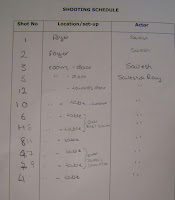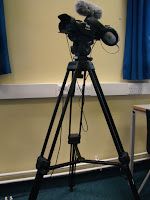Here is my prelim task
1. Who did you work with and how did you manage the task between you?
For the prelim task I worked with Aisha, Sailesh and Ray. The four of us planned the scene - storyboard, script and shoot schedule - together and edited in pairs where I was with Aisha. The majority of the filming and directing was carried out by myself and Aisha as the other two were acting in the scene, but they did help on the shots that they weren't in.
We all worked very well together and listened and discussed each others' ideas before deciding, as a group, which ones to go with and I think that is a reason why the task went as smoothly as it did for us.
 |
| My group |
2. How did you plan your sequence? What processes did you use? What theories did you try to take into account?
In the allotted hour we had to plan, my group and I started by discussing a narrative for the scene and getting a rough idea of the shots we wanted to include, the theories and rules we had to abide by and how we could explicitly meet the demands of the brief. This was followed by us blocking out each shot idea to see whether it would work before drawing them out onto our storyboard, ensuring that we had a variety of shot types and camera movement. We also created a shoot schedule, grouping similar shots and set ups together, and a script for the scene.
 |
| Our Storyboard |
 |
| Our shoot schedule |
The theories we took into account include:
- 180° rule (specified in the brief)
- match on action (specified in brief)
- shot/reverse/shot (specified in brief)
- narrative structure
- 30° rule
- master shot
These theories would all ensure that our scene achieved continuity, didn't include jump cuts and logically made sense to the audience.
In my opinion, the most important part of our planning was blocking out the shots, as this allowed us to properly visualise how they would look and ensured that they could actually be carried out in the space we had. This was particularly important as we had quite a lot of camera movement, including a slight arc and track, which was fairly difficult to position and blocking it out beforehand meant that we wasted less time during the filming hour trying to work that out.
In my opinion, the most important part of our planning was blocking out the shots, as this allowed us to properly visualise how they would look and ensured that they could actually be carried out in the space we had. This was particularly important as we had quite a lot of camera movement, including a slight arc and track, which was fairly difficult to position and blocking it out beforehand meant that we wasted less time during the filming hour trying to work that out.
3. What technology did you use to complete the task, and how did you use it?
The technology that we used to complete the task can be split into hardware and software including a canon camera, microphone, tripod and Adobe Premiere Pro.
Hardware
Camera
To film our shots we used a Canon Legria HF G30 Camera which was small, lightweight, of high quality and had auto focus. This was very helpful because it meant that we could easily change the camera position to get a variety of shots and it saved us a lot of time - which was vital as we only had an hour to film - since we didn't have to focus each individual shot or worry about them being blurry.
Microphone
We used a Canon DM - 100 Directional Microphone and headphones to try and ensure good sound quality for our clip. However, we did still get some white noise in the background and as the microphone was attached to the camera, it picked up the dialogue from that position which, while still clear, could have been better.
Tripod
We attached the camera to a Libec TH - 650 HD Tripod for the filming, which ensured that our shots were steady. The spirit level was also helpful in checking that our shots were balanced and not on a tilt, which while used sometimes in films for effect, would not have looked good throughout our entire scene.
 |
| Camera, tripod and microphone |
Software
Adobe Premiere Pro
The media technician uploaded all of our shots to the edit suites we would be using and from there we renamed our shots with the correct number and take before picking out the best ones to use in the actual clip. After that we roughly cut our chosen takes down and put them on the timeline to be more finely cut to achieve continuity. During this, we had to alter the take we were originally going to use for when one of the characters says 'It's just so unfair' because the actor had leaned too far out of shot. However, as we had shot the entire conversation from three angles, over both characters' shoulders and then as a two shot, this was not too much of a problem and we simply used a different angle for that shot. We edited on multiple tracks and, as we had no need for sound bridging, simply ensured that our audio stayed clipped to each video shot.This avoided unmatching the sound with the action which was vital for ensuring that the clip made sense, especially throughout the dialogue.
 |
| Premiere Pro screenshot |
4. What factors did you take into account when planning, shooting and editing?
There were quite a few factors that we had to take into consideration throughout the task, the biggest of which was meeting the demands of the brief in the time given.
When planning we had to ensure that we included the theories and actions specified in the brief. We had to do this quite quickly to ensure that we didn't end up making some shots up while we were filming as this would have been very stressful and probably resulted in arguing and even more time wasting, ultimately meaning that we most likely wouldn't have finished or achieved continuity.
During the filming stage we had to take into consideration the fact that we could only film in the media department. We had already arranged with the other group which classroom we would be using and when we could each use the hallway outside, which made things easier. We also had to consider furniture and props, which again we had already planned out during the story boarding stage. As the classroom we were filming in looks out over the field where P.E lessons take place we had to factor in the noise from those pupils over the dialogue which we were shooting by the windows. The theories specified in question 2 were also very important while filming to ensure that it would be possible to achieve continuity when editing. We did this by filming complete actions rather than small segments.
Throughout the editing, we had to ensure that we cut the shots in the best place to effectively match on action and achieve continuity in the time given.
In my opinion, we did successfully take all of the factors into consideration and met the brief with only a few minor errors in continuity.
In my opinion, we did successfully take all of the factors into consideration and met the brief with only a few minor errors in continuity.
5. How successful was your sequence? Please identify what worked well and, with hindsight, what would you improve/do differently?
Overall, our sequence was successful as it met the demands of the brief and achieved continuity. We managed to correctly demonstrate all of the relevant theories at least once, although there are some issues with a few shots.
I think the fact that we used the planning time effectively and actually blocked out our shots to see if they would work in practice, was a reason why we managed to achieve what we set out to do. It meant that we had a solid plan to follow in both the filming and editing stages and this in turn made it easier to complete each step in the time given.
Examples of where we followed filming rules and achieved continuity include:
Match on action
Match on action/ 180° rule/ 30° rule
Shot reverse shot
In hindsight, I would ensure that during filming we checked that the actors did any actions the same during every take. This is because where we shot the conversation from 3 different angles, to make it easier to edit, not all of the gestures stay the same across the shots. This can be seen below where Sailesh's hand ends one shot raised but at the beginning of the next shot his hand is on the table. We unfortunately didn't have any other good takes where this could have been better matched. We should also have filmed the arc and track in shot 5 in the same shot as the MLS of Sailesh walking through the door as this would have made it easier to match the action and a visible decrease in the speed of walking wouldn't be present.
Another thing that I would change if I were to do this again is to use the natural lighting that we had better, as in some shots, for example 1 and 11, it is quite hard to make out the character's features. I would also ensure that even though we were rushing towards the end we still changed the take number as this made it harder in the edit room to name and choose the best shot.
In addition to this I would ensure that our framing was spot on during the filming, as one of our shots had to be changed during editing to a different angle because of poor framing. This in turn meant that we had to switch the following shot to avoid creating a jump cut. However, this caused its own problem as the audience now can't actually see Ray when he says his line of dialogue.
Overall, I think that we were successful because on the whole continuity was achieved and even with the issues highlighted, the scene logically makes sense and flows in a realistic way.
6. What have you learnt from completing this task? Looking ahead, how will this earning be significant when completing the rest of your foundation coursework, do you think?
From completing this task, I have learnt the importance of planning and, in particular, blocking out your shots to test whether they would actually work. This is vital because if you can't accurately portray your ideas in each shot, your film will not make sense to the audience and no amount of editing can change that.







